Over a thousand individuals worked on World War Z, one of the most surprising hits of the Summer movie season, but director Marc Forser and star Brad Pitt are the ones getting all the glory (to anyone who complains, maybe they pulls a Don Draper and yell, “That’s what the money is for!”). As a result, it is nice for those equally interested in the technical side of film-making as well as the inevitable star-gazing aspect to have a book such as The Art of the Film: World War Z.
But, wait, art? I like movies; I don’t like art.
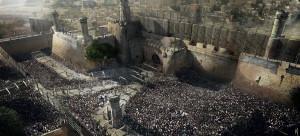
This clearly looks like art, and yet it was crucial to the creative process for a movie like World War Z.
Well, do you really like movies? Yeah? Then, trust me, you like art. An endless army of unknown names have been providing the artistic direction behind what we see on the screen for the majority of film’s history. Such people have been in even higher demand in the ever expanding age of the Hollywood Summer blockbuster. Such films routinely employ small armies of graphic artists, set designers, model makers, concept artists, illustrators and matte artists who all work under the watchful eyes of multiple production designers and art directors. According to the Art Directors Guild of America, there are over 2000 union-paying workers plying their trade in America. That’s not even mentioning those artists who work on film in different countries, such as those organized under the British Film Designers Guild in the U.K.
Obviously, a film should engage its audience on an emotional level, but even if it fails to do that one could simply sit back in awe at the artistry and technical wizardry on display. It is the job of the director, actors, editors and various others to make us care; it is the job of the artists, both on the traditional side and special effects side, to wow us. One of the earliest stages in this process, sometimes even before a script has been completed, is concept art. The Art of the Film: World War Z is chock-full of stunning concept art, such as this photo below depicting a zombie apocalypse occurring near a famous American bridge:
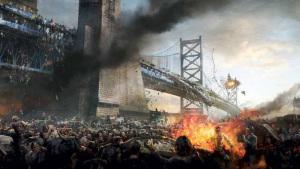
However, it’s difficult to examine any promotional information connected World War Z, which was adapted from Max Brooks’ novel of the same name, without bearing in mind the film’s notoriously troubled production. Titan Books’ The Art of the Film: World War Z chooses to de-emphasize this facet of the film’s production and focus on the film’s concept art and the thought process that went into creating the film’s rapid-fire zombie swarms.
The book’s layout presents the film’s shooting script (I have yet to see World War Z meaning I cannot say whether or not this is the script that eventually became the film currently in theaters), decorated with film stills and occasionally punctuated with quotes relating to the film from cast and crew members.
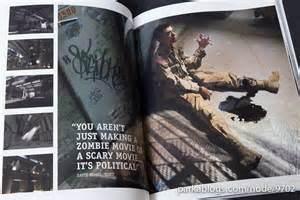
Above is an example of a typical page containing a pull-quote from a member of the World War Z crew.
The script reads effectively, with well-written dialogue and sufficient setting establishes, and the accompanying images add to the reading experience.
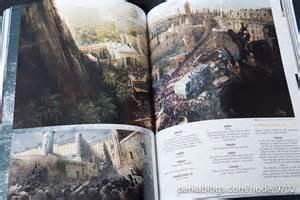
Above is an example of how the film’s script is complemented by gorgeous concept art in the book.
However, for me, the most interesting area of the book involves focusing solely on the look of and concept behind the film’s zombie hordes. Andrew R. Jones, the film’s animation consultant, describes their movements as “uncoordinated and twitchy doe to the lack of a central control system or functioning brain” and “the look of the skin and [their] skeletal nature is derived from the absence of nourishment and dehydration that would naturally occur,” implying a great deal of time and though went into the appearance and movement of Brad Pitt’s mass foes. Those final pages, stuffed to the brim with cataract-coated or blood-shot eyes, decaying musculature, and rotting limbs, and emaciated, decomposing skin provide the book’s most interesting visuals.
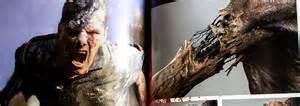
The Art of the Film: World War Z provides an interesting look at the film’s arresting, sometimes disturbing visuals that makes for an interesting read, especially when the focus is on zombie creation, but the script itself reads effectively too.
The Art of the Film: World War Z can be purchased directly from the publisher, Titan Books, as well as via Amazon or any number of other online retailers. Plus, if you want to support local check your local book store to see if they have it.
Full Disclosure: This review is based upon a copy of The Art of the Film: World War Z provided to this site for review purposes by Titan Books.

